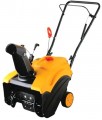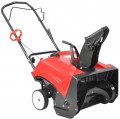Working width
The width of the strip of snow that the snow blower can clear in one pass. The larger the capture width, the fewer passes will be required to process the site, which is especially important on large areas. On the other hand, for processing small spaces, clearing individual paths, etc. significant width is not required (moreover, a “narrow” snow blower will pass more easily in a hard-to-reach place). The larger the capture width, the more powerful the engine, usually, ceteris paribus.
The most compact modern snow blowers have a working width of
less than 50 cm, these are mainly electric models of low power, although gasoline units are also found. A width of
50 – 60 cm can be called relatively small,
60 – 70 cm — medium, and in the largest models this figure
exceeds 70 cm.
Snow height
The maximum thickness of the snow layer that the snow blower removes in one pass. If you plan to regularly remove snow as it falls in a small area (for example, in the courtyard of your own private house), a grip height of up to 20 cm will be enough. If the opportunity to remove snow is rare (for example, in a country house where you visit only on weekends), you should pay attention to more powerful models with a height of about 50 cm.
Min. throw distance
The shortest distance that the snow blower can throw the collected snow.
The minimum range is indicated only for models with adjustable throw distance (see above). The meaning of this parameter is that in fact, long-range snow casting is not always desirable. For example, when clearing a path in the yard of a private house, snow often has to be poured literally next to the path, a little further — and it will fly onto the windows and walls of the house.
Note that the ejection range is a rather conditional value, because. snow (especially loose, freshly fallen snow) tends to dissipate in flight.
Max. throw distance
The maximum distance to which the snow blower can throw the collected snow (for models without throwing distance adjustment, the operating range itself). This value is rather arbitrary, since snow can be strongly dispersed in flight. Nevertheless, it characterizes the capabilities of the unit well and allows you to compare it with other models.
Long range is important mainly when working on large areas — it allows you to throw snow across the cultivated area so that it does not have to be collected a second time. As for specific figures, the value
up to 10 m is considered relatively small,
11 – 15 m — average, and in the most "long-range" models this figure can be
16 m or more.
Working mechanism
The type and material of the working mechanism, which is standardly installed in the snow blower.
—
Steel auger. An auger is a structure of several spirally curved plates that, due to rotation, ensure the movement of snow from the surface being cleared and throw it in the desired direction. Metal augers have high hardness and strength, due to which they are well suited for working with hard crust, dense compacted snow and high snowdrifts. On the other hand, such a tool can damage the coating under the snow, so such devices are poorly suited for work on paths with decorative coating. Also, a metal auger can break from a collision, say, with a stone, and therefore requires the use of safety systems (shear pins). Such augers are usually equipped with powerful self-propelled models, in which the working tool does not fit tightly to the ground.
—
Rubber auger. A type of auger (see above) made of rubberized material. Such augers are softer than steel ones, which means they can be used to clear paths with decorative coverings without fear of damaging the surface. At the same time, they are suitable for working only with loose, freshly fallen snow — such augers cope much worse with dense snowdrifts or crust than metal ones, and in this mode they quickly wear out and become unusable. Rubberized (or even solid rubber) augers are usually installed on non-self-propelled models, in which the tool can
...fit closely to the ground.
— Plastic auger. The advantages of plastic as a material for augers are low cost and good hardness, due to which such augers cope much better with frozen crust and compacted snow than rubberized ones. At the same time, they are much more careful with the road surface than metal ones, due to which they can be used almost close to the ground. At the same time, plastic is characterized by fragility and a tendency to crack when colliding with hard obstacles, and therefore this material is used relatively rarely and mainly in inexpensive snow blowers.
— Sweeper brush. A rotating cylindrical brush with long, rigid "bristles" fixed on a horizontal axis. This mechanism is designed to work with soft, loose snow of shallow depth. Its main advantage is the combination of cleanliness of processing and a good width of capture: the brush can provide a capture strip of 60-80 cm, leaving behind almost completely cleared soil. At the same time, it can be used on relatively "delicate" surfaces. But for high snowdrifts or densely packed snow, it is better to use augers.
— Steel auger/sweeper brush. In this case, the snow blower is equipped with both types of working mechanisms (see above for more details), and the operator can install the most suitable for the given conditions. This provides the greatest versatility: for example, you can remove the crust with a metal auger, and then install the brush and sweep the area clean.
— Blade. A device made of curved metal sheet for clearing snowdrifts. Allows for large volumes of work, used for clearing freshly fallen snow from access roads, parking lots, areas near garages or entrance gates to a private plot. To prevent damage to delicate road surfaces, a rubber coating is often “put on” the lower part of the blade. Based on the working situation, three fixed positions of the blade are usually assumed: vertically, with an inclination to the right or left.Engine size
The size of the engine installed in a gasoline or diesel (see "Engine type") snow blower. With the same type of internal combustion engine (see above), more displacement usually means more power and more fuel consumption.
Motor power
Snowblower motor power in horsepower.
The universal unit of power today is watts, but for petrol and diesel engines (see "Motor type"), the traditional designation in horsepower may also be given. 1 HP approximately equal to 735 watts.
The higher the motor power, the higher the performance of the snow blower, the better it handles with high dense snowdrifts and icy crust. However, more powerful engines consume more fuel, weigh more and cost more, and their use is not always justified. Detailed recommendations on choosing the optimal power for a specific situation can be found in special sources.
Motor power
Snowblower motor power in watts. This designation is used for all electric models; for units with an internal combustion engine (see "Motor type"), the designation in horsepower may also be given (see above).
The higher the motor power, the higher the snowblower's flow rate, the better it copes with high dense snowdrifts and icy crust. However, more powerful engines consume more fuel, weigh more and cost more, and their use is not always justified. Detailed recommendations on choosing the optimal power for a specific situation can be found in special sources.
Fuel tank volume
The amount of fuel that the snow blower tank can hold at one time. Knowing this figure, as well as fuel consumption (see above), you can easily calculate the approximate operating time on one gas station. However, manufacturers usually choose the volume so that the operating time reaches at least 2 – 2.5 hours, so in most cases you can not pay much attention to this parameter.

